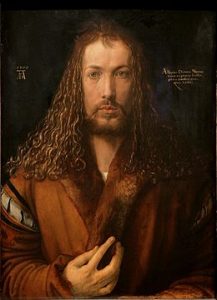
Albrecht Dürer (May 21, 1471 – April 6, 1528), is a German drawer, engraver and painter also known as the theoretician of the linear perspective’s of the geometry.His father is a goldsmith from Hungary, who arrived in Nuremberg in 1455 and his mother, daughter of a Nuremberg goldsmith. His godfather, also a goldsmith who became a printer, published in 1493 La Chronique de Nuremberg. Following his family, Albrecht Dürer begins his apprenticeship at the age of 13 using the chisel and the point. Gifted for drawing, his father allowed him to enter the studio of a painter for three years: feather and brush, copy and life drawing, landscapes with watercolour and oil, wood engraving . Then he travels: France, Italy with small breaks in Nuremberg. In 1507 he studies languages and geometry. He deepens the study of the human body. From 1510, he produces mostly engravings.
His trip to the Netherlands from 1512 leads him to the court of Emperor Maximilian 1st of Habsburg. There he receives a pension with a noble title.
Famous during his lifetime, Dürer was all the more incensed after his death that the Italian and Dutch schools dominated painting.
More than seventy paintings, more than a hundred engravings on copper, and about two hundred and fifty engravings on wood, more than a thousand drawings and three printed books have come down to us.
He dies in 1528 and is buried in the cemetery of Johanniskirchhof in Nuremberg.

Leave a Reply